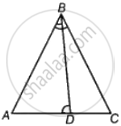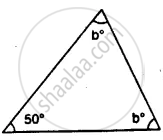Advertisements
Advertisements
प्रश्न
D is any point on side AC of a ∆ABC with AB = AC. Show that CD < BD.
उत्तर
Given in triangle ABC, D is any point on side AC such that AB = AC.

To proof that CD < BD or BD > CD
To proof: AC = AB ...[Given]
∠ABC = ∠ACB ...(i) [Angle opposite to equal sides are equal]
In triangle ABC and triangle DBC,
∠ABC > ∠DBC ...[∠DBC is a internal angle of ∠B]
∠ACB > ∠DBC ...[From equation (i)]
BD > CD ...[Side opposite to greater angle is longer]
CD < BD
APPEARS IN
संबंधित प्रश्न
The exterior angles, obtained on producing the base of a triangle both way are 104° and 136°. Find all the angles of the triangle.
In the given figure, AB || DE. Find ∠ACD.

Is the following statement true and false :
An exterior angle of a triangle is less than either of its interior opposite angles.
Mark the correct alternative in each of the following:
If all the three angles of a triangle are equal, then each one of them is equal to
If one angle of a triangle is equal to the sum of the other two angles, then the triangle is
Find the unknown marked angles in the given figure:

Q is a point on the side SR of a ∆PSR such that PQ = PR. Prove that PS > PQ.
S is any point on side QR of a ∆PQR. Show that: PQ + QR + RP > 2PS.
Bisectors of the angles B and C of an isosceles triangle with AB = AC intersect each other at O. BO is produced to a point M. Prove that ∠MOC = ∠ABC.
Can we have two acute angles whose sum is a reflex angle? Why or why not?
